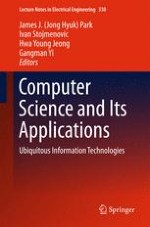The 6th FTRA International Conference on Computer Science and its Applications (CSA-14) will be held in Guam, USA, Dec. 17 - 19, 2014. CSA-14 presents a comprehensive conference focused on the various aspects of advances in engineering systems in computer science, and applications, including ubiquitous computing, U-Health care system, Big Data, UI/UX for human-centric computing, Computing Service, Bioinformatics and Bio-Inspired Computing and will show recent advances on various aspects of computing technology, Ubiquitous Computing Services and its application.
